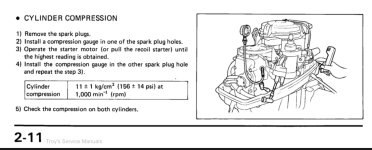First of all, thank you to everyone who’s posts I have learned from the last few weeks! I have scoured these forums while trying to get my little Honda bf9.9A to run. I bought it 2 years ago, the owner said it was a great motor but hadn’t started it for at least a year prior. So it had sat for maybe 3 years.
I bought a new tank, line, and bulb, got fresh gas, tried it and had no real luck. Recently have had reason to try again, and did get it running, after cleaning the carb and pulling until my arm was numb. As of now, I’be had the carb off to clean at least 5 times. The “idle adjust screw” -if I am even using the right term- has a “stop” on it for lack of a better word, and I don’t believe I can remove without breaking something. I have a new carb on order but it’s looking to be a wait.
It will start on the first pull, and if I kind of force the throttle handle to rev higher (doesn’t go all the way out of gear) it will stay running as long as I do that, or manually open the throttle on the carb with my finger. It does not like to be chocked at all, will not start that way. It seems to be a bit smoky as well.
Any tips are greatly appreciated, and hopefully some of the guys whose posts I have been reading will chime in!
Here is a link if a short video of it running:
[url]https://youtu.be/ipFuQtJKKbI [/URL]
I bought a new tank, line, and bulb, got fresh gas, tried it and had no real luck. Recently have had reason to try again, and did get it running, after cleaning the carb and pulling until my arm was numb. As of now, I’be had the carb off to clean at least 5 times. The “idle adjust screw” -if I am even using the right term- has a “stop” on it for lack of a better word, and I don’t believe I can remove without breaking something. I have a new carb on order but it’s looking to be a wait.
It will start on the first pull, and if I kind of force the throttle handle to rev higher (doesn’t go all the way out of gear) it will stay running as long as I do that, or manually open the throttle on the carb with my finger. It does not like to be chocked at all, will not start that way. It seems to be a bit smoky as well.
Any tips are greatly appreciated, and hopefully some of the guys whose posts I have been reading will chime in!
Here is a link if a short video of it running:
[url]https://youtu.be/ipFuQtJKKbI [/URL]
Last edited:


